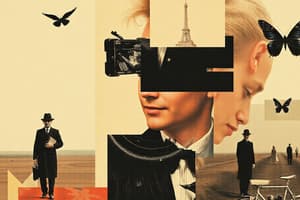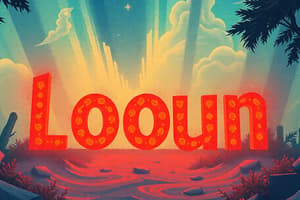Podcast
Questions and Answers
What is the relationship between codes and signs as described?
What is the relationship between codes and signs as described?
- Codes are random and do not connect signs.
- Codes only apply to single texts and are not interpretative.
- Codes organize signs into systems that correlate signifiers and signifieds. (correct)
- Codes attempt to simplify the meanings of signs.
Which aspect of femininity does Catherine Deneuve represent in relation to Chanel No. 5?
Which aspect of femininity does Catherine Deneuve represent in relation to Chanel No. 5?
- A modern and avant-garde interpretation of beauty.
- A classical and elegant French ideal of female beauty. (correct)
- An international standard of beauty that transcends cultural boundaries.
- An unconventional view of femininity that opposes traditional ideals.
What does 'Brandscapes' suggest about consumer behavior?
What does 'Brandscapes' suggest about consumer behavior?
- Signs and commodities are consumed separately from each other.
- Brandscapes signify a return to traditional shopping experiences.
- Consumers are only interested in purchasing tangible products.
- Consumers increasingly value the signs associated with products as much as the products themselves. (correct)
How much did the 'Sex and the City' movie gross during its opening weekend?
How much did the 'Sex and the City' movie gross during its opening weekend?
Which brand is featured in the 'Sex and the City' movie?
Which brand is featured in the 'Sex and the City' movie?
Which appeal in persuasion focuses on the credibility of the speaker?
Which appeal in persuasion focuses on the credibility of the speaker?
What does 'denotation' refer to in semiotic analysis?
What does 'denotation' refer to in semiotic analysis?
According to Ferdinand de Saussure, language can be analyzed as a formal system of what?
According to Ferdinand de Saussure, language can be analyzed as a formal system of what?
What does 'unlimited semiosis' suggest about the meaning of signs according to C.S. Peirce?
What does 'unlimited semiosis' suggest about the meaning of signs according to C.S. Peirce?
What is the purpose of 'feedback' in the communication process?
What is the purpose of 'feedback' in the communication process?
Which aspect of communication refers to the various elements that can distort the message being conveyed?
Which aspect of communication refers to the various elements that can distort the message being conveyed?
Who is credited with systematizing semiotic theory in relation to myth and ritual?
Who is credited with systematizing semiotic theory in relation to myth and ritual?
What term refers to the socio-cultural and personal associations of a sign?
What term refers to the socio-cultural and personal associations of a sign?
What term describes a word that has several meanings, such as 'bank' referring to both a financial institution and the edge of a river?
What term describes a word that has several meanings, such as 'bank' referring to both a financial institution and the edge of a river?
Which type of reading in Stuart Hall's Reception Theory refers to the interpretation that aligns with the intended message of a text?
Which type of reading in Stuart Hall's Reception Theory refers to the interpretation that aligns with the intended message of a text?
Which concept refers to the framework that provides an identifiable social or communicative function in interpreting signs?
Which concept refers to the framework that provides an identifiable social or communicative function in interpreting signs?
Which statement best describes 'anchorage' in visual texts?
Which statement best describes 'anchorage' in visual texts?
What is the term used to describe the idea that a text exists in relation to other texts, as articulated by Julia Kristeva?
What is the term used to describe the idea that a text exists in relation to other texts, as articulated by Julia Kristeva?
Which type of code is described as using familiar terms and concepts for a broad audience?
Which type of code is described as using familiar terms and concepts for a broad audience?
According to Roland Barthes, how does he suggest a text is constructed?
According to Roland Barthes, how does he suggest a text is constructed?
What does the term 'lapsed signifiers' refer to?
What does the term 'lapsed signifiers' refer to?
What does visual literacy encompass?
What does visual literacy encompass?
What is a primary purpose of visuals in communication?
What is a primary purpose of visuals in communication?
Which key element is NOT part of visual communication?
Which key element is NOT part of visual communication?
Intertextuality in visual communication refers to which of the following?
Intertextuality in visual communication refers to which of the following?
Which aspect does NOT influence the audience in visual communication?
Which aspect does NOT influence the audience in visual communication?
What is the main goal of visual communication?
What is the main goal of visual communication?
What does the term 'brandscapes' in visual communication imply?
What does the term 'brandscapes' in visual communication imply?
Which of the following is NOT a key element of visual communication?
Which of the following is NOT a key element of visual communication?
Flashcards
Semiotics
Semiotics
The study of how signs and symbols communicate meaning.
Communication
Communication
The process of creating and sharing information between a sender and a receiver.
Logos
Logos
An appeal to logic, using reason and evidence to persuade.
Pathos
Pathos
Signup and view all the flashcards
Ethos
Ethos
Signup and view all the flashcards
Denotation
Denotation
Signup and view all the flashcards
Connotation
Connotation
Signup and view all the flashcards
Culture
Culture
Signup and view all the flashcards
Code
Code
Signup and view all the flashcards
Anchorage
Anchorage
Signup and view all the flashcards
Polysemy
Polysemy
Signup and view all the flashcards
Dominant Reading
Dominant Reading
Signup and view all the flashcards
Oppositional Reading
Oppositional Reading
Signup and view all the flashcards
Negotiated Reading
Negotiated Reading
Signup and view all the flashcards
Intertextuality
Intertextuality
Signup and view all the flashcards
Range of Possible Meanings
Range of Possible Meanings
Signup and view all the flashcards
Codes in Semiotics
Codes in Semiotics
Signup and view all the flashcards
Brandscapes: Consuming Signs
Brandscapes: Consuming Signs
Signup and view all the flashcards
Juxtaposition in Advertising
Juxtaposition in Advertising
Signup and view all the flashcards
Connotative Marketing
Connotative Marketing
Signup and view all the flashcards
Visual Literacy
Visual Literacy
Signup and view all the flashcards
Visual Communication
Visual Communication
Signup and view all the flashcards
Encoding Your Communication
Encoding Your Communication
Signup and view all the flashcards
Clarifying and Simplifying with Visuals
Clarifying and Simplifying with Visuals
Signup and view all the flashcards
Attracting and Reinforcing with Visuals
Attracting and Reinforcing with Visuals
Signup and view all the flashcards
Brandscapes
Brandscapes
Signup and view all the flashcards
Study Notes
Visual Communication (CM4203)
- Visual communication is a problem-solving business practice that uses images and text to communicate various messages (personal, cultural, or commercial).
- Key elements include typography, illustration, photography, interactivity, and moving images.
- Visual literacy is the ability to both create and interpret visuals.
- Visuals, like words, can carry connotative or symbolic meaning.
- Visual design is often governed by conventions that establish audience expectations.
Communications Definition
- Communications is the science and practice of transmitting information.
- Communication studies examine how human meanings are created.
Persuasion
- Logos: Appeal to logic
- Pathos: Appeal to emotion
- Ethos: Appeal to credibility
The Communication Process
- The process involves a sender, encoding, media message, decoding, and a receiver, all within a context.
- Noise can interfere with the process.
- Feedback is part of the loop, and the whole process repeats with a response.
Semiotics
- Semiotics is the science of communication signs.
- Ferdinand de Saussure (1857-1913) laid the foundation for 20th-century linguistics and developed the idea of semiology, which is now known as semiotics.
- Semiotics analyses language as a formal system of organized differences.
- Roland Barthes (1915-1980): A French critic who made structuralism a leading intellectual movement with his work on semiotics.
- C.S. Peirce: Introduced the idea of "unlimited semiosis", suggesting that the meaning of signs is never truly fixed.
Semiotics Analysis
- Denotation: A literal, obvious, and commonplace meaning of a sign.
- Connotation: The socio-cultural and personal associations (e.g., ideological, emotional) of a sign.
Concepts/Signs
- Culture comprises shared conceptual maps, language systems, and codes.
- Words and images carry meaning and require interpretation.
- Codes provide the framework for interpreting signs.
Anchorage
- Images often have multiple interpretations.
- Anchorage occurs when text is used to focus on a specific meaning, or to guide viewers through various meanings.
Polysemy
- Polysemy refers to a word having multiple meanings.
- Example: "Bank" (of a river/canal), (a place for depositing money), (a slope, etc.).
Stuart Hall – Reception Theory
- Dominant reading (preferred reading)
- Oppositional reading
- Negotiated reading
Codes
- Codes perform specific social or communicative functions.
- Broadcast codes use common terms and concepts.
- Narrowcast codes target a specific, limited audience.
Intertextuality
- Intertextuality refers to the connections between texts (form and content).
- Texts exist in relationship to one another.
- Memes are an example of intertextuality.
- Texts draw on, combine, transform, or otherwise refer to other texts.
Purposes of Visuals
- Clarity
- Simplification
- Reinforcement
- Attract attention
- Impress
- Unify
Visual Communication and Practice
- Visual communication is a problem-solving business practice.
- Visual communication is important for solving specific business issues.
- The elements of visual communication include typography, illustration, photography, interactivity, and moving images.
Exam Information
- Midterm exam scheduled for Thursday, October 17, 2024, at 1:00 PM.
- Exam duration is 35 minutes.
- The exam comprises 30 multiple-choice questions and select-all-that-apply style questions.
Other Topics (Covered in the Slides)
- Fundamentals of Communication
- Perception/Intrapersonal Communication
- Emotional and Social Intelligence
- Workplace Communication
- Dyadic communication (communication with one other person)
- Lapsed Signifiers (covered in the Rachel Lawes article - not defined in the slides)
Studying That Suits You
Use AI to generate personalized quizzes and flashcards to suit your learning preferences.




